Contents
Input devices: a usage-driven approach
Mouse
I doubt they were built for hand safety: mice inherently strain the hand... |
The mouse is a spoiler. Whenever you put your hand on it, you stress your body. If for a moment you forget to apply a lifting force to your fingers, then buttons are immediately activated. Consequently, your body must work constantly with shoulder, limb, hand, and finger positions to not press buttons. Unless, of course, you take your hand away from the device. Something the size and shape of it discourage you from doing. The lighter the mouse buttons are to depress, and the bigger they are, the more static force is needed to prevent accidental mouse clicks. Thus, curiously, there may be a direct relationship between how "ergonomic" the mouse is and how harmful it is.
The keyboard is much more forgiving in this regard. It is natural to rest the hands in front of the keyboard as soon as they are not in use. But given that the mouse inherently forces an unnatural, constant muscle response, I believe that researching mouse curvatures alone is an exercise in futility.
The buttonless mouse
Instead, mouse buttons must be entirely removed from the pointing device itself. This is not a radical idea: on laptops, the pointing device (stick or pad) is separated from the buttons. Also, the new mouse feature called a scroll-wheel should be moved to the keyboard. The mouse is the last place another function should be placed. Finally, the proper mouse size is less than the standard one.
Now what are the consequences? The series of pictures below illustrate five of numerous ways a small, buttonless mouse can be manipulated. (The mouse shown has actually its buttons disabled.) Most of these poses are not possible with a conventional mouse unless various fingers are counter-balanced to not depress the buttons.
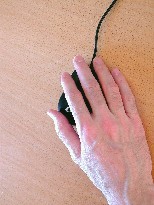
One-handed finger ride |
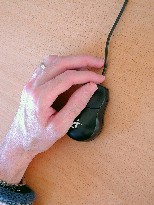
One-handed side grasp |
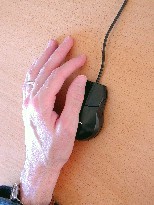
One-handed thumb ride |
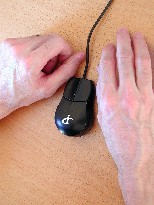
Two-handed shove |
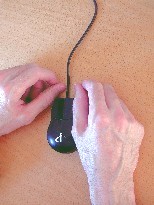
Two-hands semi-ride |
These pictures indicate how an appropriate shape allows the the mouse to be manipulated by just putting a part of the hand on top of it, while the side of the hand still rests on the table. This easy-on-off principle encourages the hand to rest on the desk, not on top of the mouse. It is still possible to have the hand ride on top of the mouse—while the hand gets gets a lot of support both from the desk, because the mouse fits in the palm of the hand, and from the mouse itself, because of the lack of buttons. Note that to use the mouse in such varied ways, where hands are given plenty of resting areas, more space is needed than what is usually available on a keyboard tray. That's why I believe that reducing keyboard size, or getting rid of it by combining speech recognition and foot pedals, is very important.
And where do the buttons go?
The buttons may go on either side of the keyboard or be foot activated. In keyboard, I propose how scrolling functionality and mouse buttons can be conveniently combined on a keyboard. This arrangement will not slow you down: as one hand is leaving the keyboard to locate the mouse, the other slides to the side where the buttons are easily found. And, in foot pedals I consider available and future foot switches.
Trials
I believe that it would be interest to carry out controlled trials of simplified, buttonless mouse designs. If the design of the mouse impacts its injury potential, then a study is more likely to demonstrate this effect the larger it is. The removal of buttons may offer the best chance for obtaining such an effect.
 printer-friendly version
printer-friendly version e-mail Klarlund
e-mail Klarlund Nils
Klarlund home
Nils
Klarlund home